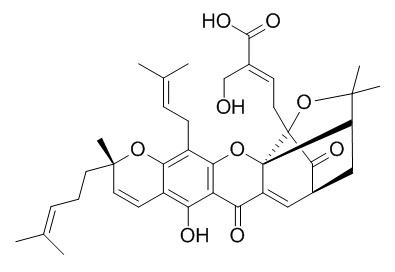30-Hydroxygambogic acid
30-Hydroxygambogic acid exhibits significant cytotoxicities against the human leukemia K562/S and the corresponding doxorubicin-resistant K562/R cell lines.
Inquire / Order:
manager@chemfaces.com
Technical Inquiries:
service@chemfaces.com
Tel:
+86-27-84237783
Fax:
+86-27-84254680
Address:
1 Building, No. 83, CheCheng Rd., Wuhan Economic and Technological Development Zone, Wuhan, Hubei 430056, PRC
Providing storage is as stated on the product vial and the vial is kept tightly sealed, the product can be stored for up to
24 months(2-8C).
Wherever possible, you should prepare and use solutions on the same day. However, if you need to make up stock solutions in advance, we recommend that you store the solution as aliquots in tightly sealed vials at -20C. Generally, these will be useable for up to two weeks. Before use, and prior to opening the vial we recommend that you allow your product to equilibrate to room temperature for at least 1 hour.
Need more advice on solubility, usage and handling? Please email to: service@chemfaces.com
The packaging of the product may have turned upside down during transportation, resulting in the natural compounds adhering to the neck or cap of the vial. take the vial out of its packaging and gently shake to let the compounds fall to the bottom of the vial. for liquid products, centrifuge at 200-500 RPM to gather the liquid at the bottom of the vial. try to avoid loss or contamination during handling.
Antimicrob Agents Chemother.2024, e0031424.
Mal J Med Health Sci.2024, 20(SUPP5):151-156.
Metabolites.2023, 13(6):689.
Appl. Sci.2022, 12(4), 2032.
Pharmacogn J.2022, 14(2):350-357
Natural Product Res.&Deve.2022, 1001-6880.
Comput Biol Chem.2019, 83:107096
Current Topics in Nutraceutical Research2021, 19(1),p90-105.
Front Pharmacol.2022, 13:870553.
Phytomedicine.2019, 62:152962
Related and Featured Products
Chem Biodivers. 2006 Jan;3(1):101-5.
A pair of novel cytotoxic polyprenylated xanthone epimers from gamboges.[Pubmed:
17193222 ]
METHODS AND RESULTS:
Two new polyprenylated xanthone epimers were isolated from gamboges of Garcinia hanburyi, and identified by detailed spectroscopic analysis as 30-Hydroxygambogic acid (2a) and its (2S)-epimer 30-hydroxyepigambogic acid (2b).
CONCLUSIONS:
Both compounds exhibited significant cytotoxicities against the human leukemia K562/S and the corresponding doxorubicin-resistant K562/R cell lines (Table 2).
J Sep Sci. 2007 Feb;30(3):304-9.
Rapid determination of polyprenylated xanthones in gamboge resin of Garcinia hanburyi by HPLC.[Pubmed:
17396587]
METHODS AND RESULTS:
A rapid ion-pair HPLC method was developed and validated for the determination of eight polyprenylated xanthones including three pairs of epimers, namely morellic acid (MA), 30-Hydroxygambogic acid (HGA), 30-hydroxyepigambogic acid (HEGA), isogambogic acid (IGA), epiisogambogic acid (EIGA), gambogenic acid (GNA), gambogic acid (GA), and epigambogic acid (EGA), in gamboge resin of Garcinia hanburyi. The separation was performed on a narrow bore C8 column with isocratic elution using a mixture of methanol-ACN-40 mM KH2PO4 buffer (37.5:37.5:25 v/v/v, containing 0.1% tetradecyltrimethylammonium bromide). The newly developed method was used to determine the contents of the eight compounds present in the gamboge.
CONCLUSIONS:
Results showed that GA and EGA are the dominant components of gamboge. The content ratio of each epimer pair remained constant, indicating that the content ratio of epimers can be used as a specific characteristic for the quality control of gamboge.



